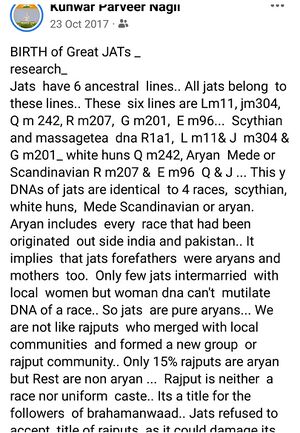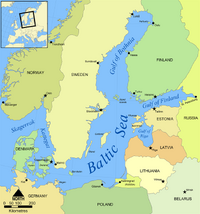Genetics of Jat Federation

Today, we humans have entered an age, when along with literature, we also have the assistance of archaeology, epigraphy, paleography, genetic studies, medical anthropology, etc. to fill the gaps and holes in the timeline of our history. We believe that, in the near future, the increasing scientific approach towards the study of history will be helpful in solving the unsolved riddles in the history of the world, and along with that, the unsolved riddles in the history of the Jat Federation.
So far, only a few genetic studies have been conducted on the Jats. However, to assist the researchers, we have listed the findings from some of them which are also presently mentioned on several pages of this website. Please note that this list does not reflects all the genetic studies done on the Jats, and it might be updated with time.
Jat People Genetics

A recent study of the people of Indian Punjab, where about 40% or more of the population are Jat people, strongly shows that the Jat people are Indo-Scythians.[1] The study involved a genealogical DNA test which examined single nucleotide polymorphisms (mutations in a single DNA "letter") on the Y chromosome (which occurs only in males). Jats share many common haplotypes with Ukrainian people, Germanic people, Slavic people, Baltic peoples, Iranian people, and Central Asian groups.[2] This strongly indicates they originate from near or in Ukraine.[3] It found Jat people share only two haplotypes, one of which is also shared with the population of present-day Turkish people, and have few matches with neighbouring Pakistani populations.[4] This haplotype shared between the two Jat groups may be part of an Indo-Aryan (or Indo-European people) genetic contribution to these populations, where as the haplotypes shared with other Eurasian populations is due to the strong DNA contributions of Indo-European Scythians (Saka, Massagetae) and White Huns.[5] The mitochondrial DNA (mtDNA) female DNA, Jats contain haplogroups typical of Northern India, Pakistan, and West Asia. This indicates that for the female mtDNA, there is very little connection with Central Asian and northwest European populations, even though Jats share many Y-SNP markers with these populations. Therefore, this DNA Study proves that there has been male DNA into the Jat people from Ukrainian Scythians (Saka, Massagetae) and White Huns.[6]
MAIN POINT IMPORTANT: Jat People Genetics
The highlighted DNA Study proves that there has been male DNA into the Jat people from Ukrainian Scythians (Saka, Massagetae) and White Huns.[7]
IMPORTANT POINT: The Jat people's FATHERS were Scythians (Saka, Massagetae) and White Huns.
DNA study on Y-STR Haplogroup Diversity in the Jat Population
David G. Mahal and Ianis G. Matsoukas[8] conducted a scientific study on Y-STR Haplogroup Diversity in the Jat Population of which brief Conclusion is as under:
The Jats represent a large ethnic community that has inhabited the northwest region of India and Pakistan for several thousand years. It is estimated the community has a population of over 123 million people. Many historians and academics have asserted that the Jats are descendants of Aryans, Scythians, or other ancient people that arrived and lived in northern India at one time. Essentially, the specific origin of these people has remained a matter of contention for a long time. This study demonstrated that the origins of Jats can be clarified by identifying their Y-chromosome haplogroups and tracing their genetic markers on the Y-DNA haplogroup tree. A sample of 302 Y-chromosome haplotypes of Jats in India and Pakistan was analyzed. The results showed that the sample population had several different lines of ancestry and emerged from at least nine different geographical regions of the world. It also became evident that the Jats did not have a unique set of genes, but shared an underlying genetic unity with several other ethnic communities in the Indian subcontinent. A startling new assessment of the genetic ancient origins of these people was revealed with DNA science.
The human Y-chromosome provides a powerful molecular tool for analyzing Y-STR haplotypes and determining their haplogroups which lead to the ancient geographic origins of individuals. For this study, the Jats and 38 other ethnic groups in the Indian subcontinent were analyzed, and their haplogroups were compared. Using genetic markers and available descriptions of haplogroups from the Y-DNA phylogenetic tree, the geographic origins and migratory paths of their ancestors were traced.
The study demonstrated that based on their genetic makeup, the Jats belonged to at least nine specific haplogroups, with nine different lines of ancestry and geographic origins. About 90% of the Jats in our sample belonged to only four different lines of ancestry and geographic origins:
1. Haplogroup L (36.8%)- The origins of this haplogroup can be traced to the rugged and mountainous Pamir Knot region in Tajikistan.
2. Haplogroup R (28.5%): From somewhere in Central Asia, some descendants of the man carrying the M207 mutation on the Y chromosome headed south to arrive in India about 10,000 years ago (Wells, 2007). This is one of the largest haplogroups in India and Pakistan. Of its key subclades, R2 is observed especially in India and central Asia.
3. Haplogroup Q (15.6%): With its origins in central Asia, descendants of this group are linked to the Huns, Mongols, and Turkic people. In Europe it is found in southern Sweden, among Ashkenazi Jews, and in central and Eastern Europe such as, the Rhône-Alpes region of France, southern Sicily, southern Croatia, northern Serbia, parts of Poland and Ukraine.
4. Haplogroup J (9.6%): The ancestor of this haplogroup was born in the Middle East area known as the Fertile Crescent, comprising Israel, the West Bank, Jordon, Lebanon, Syria, and Iraq. Middle Eastern traders brought this genetic marker to the Indian subcontinent (Kerchner, 2013).
5.-9. Haplogroups E, G, H, I, T (9.5%): The ancestors of the remaining five haplogroups E, G, H, I, and T can be traced to different parts of Africa, Middle East, South Central Asia, and Europe (ISOGG, 2016).
Therefore, attributing the origins of this entire ethnic group to loosely defined ancient populations such as, Indo-Aryans or Indo-Scythians represents very broad generalities and cannot be supported. The study also revealed that even with their different languages, religions, nationalities, customs, cuisines, and physical differences, the Jats shared their haplogroups with several other ethnic groups of the Indian subcontinent, and had the same common ancestors and geographic origins in the distant past. Based on recent developments in DNA science, this study provided new insights into the ancient geographic origins of this major ethnic group in the Indian subcontinent. A larger dataset, particularly with more representation of Muslim Jats, is likely to reveal some additional haplogroups and geographical origins for this ethnic group.
"NE Euro" fractions in DNA samples of Jats

In August 2013, the geneticist Razib Khan wrote in an article for the Discover Magazine:
- "Finally let's move to North India, and the zone stretching between Punjab in the Northwest and Bihar in the East. Though in much of this region Brahmins have higher "NE Euro" fractions, this relationship seems to breakdown as you go northwest. The Jatt community in particular seems to have the highest in the subcontinent. There are inchoate theories for the origins of the Jatts in Central Asia. I had dismissed them, but am thinking now they need a second look. The reasoning is simple. The Jatts of the eastern Punjab have a higher fraction of "NE Euro" than populations to their northwest (Pathans, Kalash, etc.), and Brahmin groups (e.g., Pandits) in their area who are theoretically higher in caste status. This violation of these two trends implies something not easily explained by straightforward social and geographic processes. The connection between ancestry and caste status also seems to break down somewhat in the Northwest, as there is a wide variation in ancestral components."[9]
- Sequenced DNA Sheds Light on Origins of First Scandinavians
- "Scandinavia was one of the last areas of Europe to be inhabited, due to a combination of a harsh climate and an ice sheet preventing colonisation by early humans. Two distinct genetic variations bear witness to two main immigration waves, one from the south (present-day Germany) and the other one from the northeast (present-day Russia)."[10]
Gallery
-
Sampling Locations, ADMIXTURE, and Shared Drift in Northwest India
-
IBD Sharing and Ancestry Profile of PNWI Populations
-
Proportions of Ancient Ancestry in South Asian Populations — qpAdm plot indicating proportions of ancestry made up of ancient sources (Iran_N, Steppe_MLBA, and Onge) among different South Asian populations
Conclusion from the QPADM table
Author: Navtej Singh Mangat
From the Qpadm table, the conclusion is that among the entire South Asia population Jats have the highest percentage of Steppe Migratory DNA in common with modern day Western and Northern Europeans ( i.e, making Jats in South Asia the purest Aryans so to speak insofar as Steppe Migratory DNA equates with the diaspora from lands associated with Aryans i.e, Southern Russia between Aral and Caspian Seas ). Brahmins, Pashtuns, peoples in NW Frontier ( Kalash people, Chitral, Gilgit etc ), Rajputs and Khatris have significantly less Steppe Migratory DNA than us.
The lvs gene shown in the Qpadm table is the dominant component in most Indians. As stated, Jats have the highest steppe ancestry along with Rors. In the Qpadm table we have the run of almost all castes of North Indians. The Qpadm table is the most accurate chart widely accepted and acknowledged by geneticists worldwide. In this chart, Rajasthani Rajputs score like gujjars and UP rajputs are a hybrid of Brahmin, kurmi, yadav, bhar type populations. Some Rajputs are identical to Haryana chamars.
Although there may be some disparity between the Qpadm and other tables, the results are nonetheless consistent to the extent that according to the American Journal of Human Genetics, Jats of South Asia share as much as 63% of Steppe Migratory DNA with modern day Europeans.
Source - The Genetic Ancestry of Modern Indus Valley Populations from Northwest India
See also
- Jñāti (ज्ञाति)
- Sangha (संघ)
- Gana (गण)
- Janapada (जनपद)
- Khap (खाप)
- List of Events in Jat History
- Ancient Jat history
- Jats in Indian epics
- Jat Kingdoms in Ancient India
- Rajasthan men Jat Janpad
- List of Mahabharata people and places
- Indian History Time Line
References
- ↑ YHRD - Y Chromosome Haplotype Reference Database
- ↑ YHRD - Y Chromosome Haplotype Reference Database
- ↑ YHRD - Y Chromosome Haplotype Reference Database
- ↑ YHRD - Y Chromosome Haplotype Reference Database
- ↑ YHRD - Y Chromosome Haplotype Reference Database
- ↑ YHRD - Y Chromosome Haplotype Reference Database
- ↑ YHRD - Y Chromosome Haplotype Reference Database
- ↑ Y-STR Haplogroup Diversity in the Jat Population Reveals Several Different Ancient Origins
- ↑ Author: Razib Khan. Article: What the Harappa Ancestry Project has resolved. Magazine: Discover Magazine. Published: 04 August 2013.
- ↑ Author: Igor Kuznetsov. Article: Sequenced DNA Sheds Light on Origins of First Scandinavians (Archived). Publisher: Sputnik International. Published: 30 August 2021.
External links
- Authors: Ajai K. Pathak, Anurag Kadian, Alena Kushniarevich, Francesco Montinaro, Mayukh Mondal, Linda Ongaro, Manvendra Singh, Pramod Kumar, Niraj Rai, Jüri Parik, Ene Metspalu, Siiri Rootsi, Luca Pagani, Toomas Kivisild, Mait Metspalu, Gyaneshwer Chaubey, Richard Villems. Article: The Genetic Ancestry of Modern Indus Valley Populations from Northwest India. Journal: The American Journal of Human Genetics (Volume: 103, Issue: 6, Pages: 918–929). Published: 06 December 2018.
Further reading
- Author: Bhupinder Singh Mahal. Book: Origin of Jat Race: Tracing Ancestry to the Scythians of Antiquity. Publisher: Munshirm Manoharlal. Published: 30 November 2015. ISBN 8121512913, 9788121512916. | (Editorial Review)
- Author: David G. Mahal. Book: Ancestral Roots of the Jats: DNA Revelations. Publisher: DGM Associates. Published: 02 March 2015. ISBN 0692369597, 9780692369593.
- Author: David G. Mahal. Book: Before India: Exploring Your Ancestry with DNA. Publisher: DGM Associates. Published: 06 October 2014. ISBN 0692218203, 9780692218204. | (Editorial Review)








